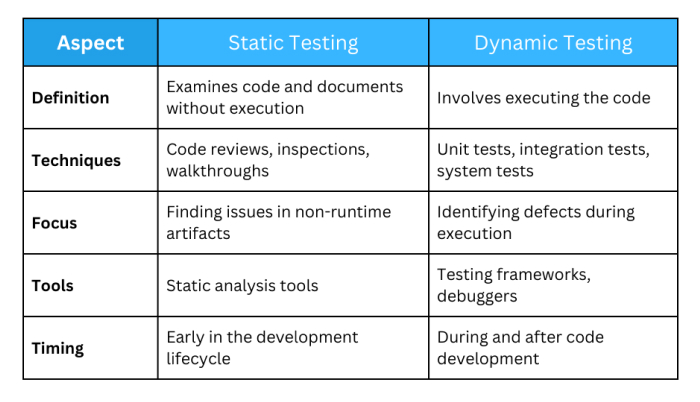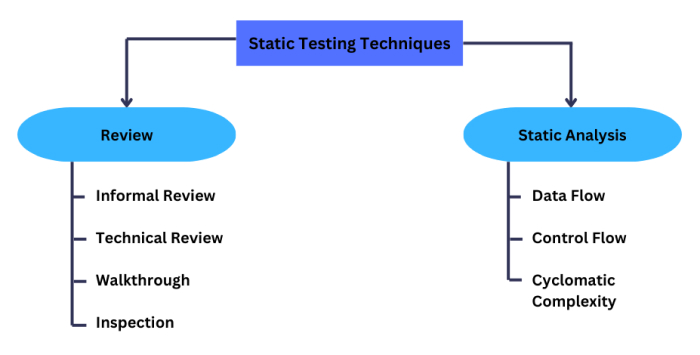Static Testing
Quality and reliability are two crucial aspects that need to be achieved when building software. These attributes ensure that your end users remain satisfied and are able to get their work done without any issues. But they must be maintained right from the start and not only at the end.
In fact, they can be achieved by adopting static testing within the software development life cycle. Starting from the earliest stages of development, static testing is one of the key practices that aid in evaluating and identifying potential errors.
What is Static Testing?
Static testing is a software testing practice that evaluates software artifacts, such as source code and associated documentation, without actually executing the program.
Simply put, it is a type of white-box testing, also known as dry run testing and verification testing.
Static testing mainly focuses on identifying inconsistencies, typos, defects, and deviations from standards to achieve an uncomplicated and error-free development process. This comprehensive analysis and evaluation of software artifacts allows the testing teams to report the identified issues and bottlenecks early on.
Thus, static testing helps prevent such flaws from escalating into complications, ultimately saving your organization time and resources.
The main objectives of static testing are to enhance overall development productivity, minimize the risk of facing complicated defects during and after development, and verify that the product aligns with the predefined specifications, requirements, and system designs.
Static Testing vs Dynamic Testing
Unlike static testing, dynamic testing involves executing the code to discover bugs and defects during the runtime. The following comparison table shows the prominent differences between the two testing types.
But, rather than being a replacement for dynamic testing, static testing is an approach that complements the dynamic testing of the same product by pinpointing issues that might not appear during program execution.
For example, it could help you identify design flaws, logical and structuring errors, dead code, or coding standard and guideline violations that may not be visible during the execution.
Techniques of Static Testing
Several methods of static testing exist, mainly categorized under the two key techniques of static review and static analysis.
Static Review
Usually, the reviewers, designers, and architects manually review the supporting documentation, especially the specifications and designs, to identify issues pertaining to consistency, accuracy, and other sources of potential failure.
There are four main stages to conducting a review process:
- Informal review: Informal reviews don’t have a set process to identify issues but involve a casual evaluation of the documents shared by the document designer among the team members. This is beneficial as it provides immediate feedback.
- Technical review: A technical review is conducted by an internal and qualified group of personnel using a more structured approach. It focuses on the technical content’s accuracy and alignment with industry standards.
- Walkthrough: A subject matter expert or the document author conducts the walkthrough in a knowledge transfer approach, explaining the intricacies and answering the questions that arise during the session. It helps determine the feasibility of the strategies and designs with feedback and shared opinions of the participants.
- Inspection: Different parties, such as the manager, reviewers, and inspection moderator, come together to conduct a strict review of the documentation and designs. It is the most formal type of review in static testing.
A well-structured static review can help identify design defects, documentation inconsistencies, and missing requirements.
Static Analysis
On the other hand, static analysis often involves using specialized code analysis tools to examine code for potential defects and other quality metrics without executing the program. It is effective for detecting code-related inconsistencies such as dead code, infinite loops, and unused variables.
There are three techniques to conduct a static analysis:
- Data flow analysis: This technique examines the flow of data and their interactions through the code to identify anomalies related to data misuse and variable usage.
- Control flow analysis: Control flow analysis evaluates the paths that the program execution may take, identifying unreachable code and infinite loops to ensure that all parts of the code function as planned.
- Cyclomatic complexity: This measures the number of independent paths through the program source code to assess the complexity of the code.
What Do You Test During Static Testing?
For maximum coverage, there is a range of artifacts and areas subjected to static testing, such as:
- Business requirement specifications
- Functional requirements
- Design documents
- Test cases, test scripts, and test data
- Prototypes and prototype specifications
- Requirement traceability matrix
- Source code
- User manuals and training guides
- Database design
By comprehensively analyzing and evaluating the above material, static testing helps ensure that the software’s foundational elements are solid and the product is high quality.
Advantages of Static Testing
Adopting static testing provides some great benefits, such as:
- Early defect detection: Facilitates the detection of potential errors and defects during the earliest stages of the software development life cycle. Thus, static testing helps improve the overall software quality and reduces the risk of major defects surfacing during later stages.
- Cost-effective: Saves resources, including funds and time, by minimizing the need for extensive rework and issue resolution after deployment.
- Compliance with standards: Static testing helps confirm that the code complies with industry standards. It assures your code is well-structured, granting better maintainability and improved code quality.
- Feedback: Static testing during the early phases of analysis and design can provide invaluable feedback that helps optimize the development and even the dynamic testing processes conducted later on.
- Comprehensive documentation and team collaboration: When static testing is in practice, regular reviews and inspections trigger the production and maintenance of detailed, up-to-date specifications and documentation. It also facilitates knowledge sharing and promotes collaboration among team members.
Disadvantages of Static Testing
However, there can be drawbacks to using static testing, too. Given its static nature, some of the commonly found issues with this approach include:
- Time-consuming: If inefficiently managed, the manual code reviews and inspections can be time-consuming, slowing down the development process. It is a prominent drawback, especially when large and complex projects are involved.
- Scope limitations: Static testing alone cannot detect runtime errors, dynamic behavior-related issues, and performance issues.
- Comprehensive and accurate documentation required: Static testing focuses heavily on documentation, so poor documentation and designs can hinder testing effectiveness.



